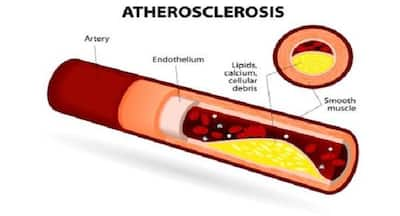Don’t Miss Out on the Latest Updates.
Subscribe to Our Newsletter Today!
Study raises hope of new atherosclerosis treatment: Know all about this condition

A new study brings hope that a novel therapeutic approach to halt and reverse plaque build-up and the progression of atherosclerosis may be coming soon. Read on to know more.
Arteries are the pathways through which blood flows from the heart to the rest of the body. A thin layer of cells, the endothelium, line the arteries. The endothelium ensures the smooth flow of blood. But if there is any damage to the endothelium, it can cause hardening of the arteries or atherosclerosis. This damage is usually caused by high blood pressure, smoking or high cholesterol, which leads to the formation of plaque on arterial walls.
Plaque build-up is a progressive condition that often comes with no symptoms. Gradually, it leads to blocked arteries that restrict the flow of blood. It can put you at risk of heart attacks, strokes and peripheral arterial disease. These are major contributors to cardiovascular diseases. It can also lead to chronic kidney disease if plaque builds up in the renal arteries. These arteries supply oxygen-rich blood to your kidneys.
Now, researchers of a new study at Yale University, have revealed previously unknown factors that may contribute to the hardening of arteries and plaque growth, which cause heart diseases. The findings of this study can be the basis for a promising therapeutic approach to halt and reverse plaque build-up and the progression of disease. Nature Metabolism published this study online.
PLAQUE BUILD-UP IN ARTERIES CAN BE REVERSED: EXPERTS
During the course of the above-mentioned study, the Yale researchers tuned in their attention on a group of proteins, called transforming growth factor beta (TGF ). This protein regulates a wide range of cells and tissues throughout the body. They saw that TGF proteins trigger inflammation in endothelial cells, that form the inner lining of artery walls, but not in other cell types. Using the single cell RNA-seq analysis technique, which measures the expression of every gene in single cells, they showed that TGF induced inflammation in these cells in mouse models. This finding was notable, said the researchers, because TGF proteins decrease inflammation in other cells in the body.
Researchers say that when the TGF receptor gene is deleted in endothelial cells, both inflammation and plaque in blood vessels reduce. To test this approach as a potential therapy, researchers used an 'interfering' RNA or RNAi, a drug developed at Yale, to disrupt TGF receptors. Interfering RNA use a gene's own DNA sequence to turn off or silence the gene. To deliver the drug only to endothelial cells in the blood vessel walls of mice, they used microscopic particles, or nanoparticles, developed by fellow researchers at MIT. This reduced inflammation and plaque build-up as effectively as the genetic technique.
These findings identify TGF signalling as a major cause of chronic vessel wall inflammation. It also proves that disruption of this pathway can end inflammation and reverse plaque build-up.
PREVENT ATHEROSCLEROSIS WITH LIFESTYLE CHANGES
Plaque build-up and hardening of arteries are progressive conditions but easily preventable. The first thing you need to do is reduce your bad cholesterol levels. For this, you need to start a daily exercise regime and follow a healthy diet. Add a lot of fresh fruits and vegetable to your diet. Stay away from processed and fatty foods.
Quit smoking and limit your alcohol intake. Take care of your health and keep cholesterol levels and blood pressure under control.
Also, make sure your blood sugar levels are within the normal range. A study at the University of Rochester Medical Center says that diabetes, by driving inflammation and slowing blood flow, dramatically accelerates atherosclerosis. High blood sugar increases the production of free radicals, causing premature cell death and it also reduces the availability of nitric oxide, which would otherwise enable blood vessels to relax and blood flow to increase. The journal Circulation Research published this study.
If you reduce the risk factors of atherosclerosis, you may slow or stop the process of plaque build-up. It will definitely lower your risk of heart attacks and strokes but will not unclog your arteries.
TREATMENT OPTIONS FOR ATHEROSCLEROSIS
Removing plaque from your arteries is not easy. All the procedures carry the risk of serious complications. The best thing to do is prevent this condition. If you are suffering from atherosclerosis, you doctor will recommend certain invasive procedures to remove the offending plaques from your arteries. You doctor may either unclog the arteries or make a path for blood to flow around the blocked arteries. A doctor will perform these procedures only in severe cases. It can affect a person's lifestyle and increase his risk of other disorders.
Let us look at a few of these procedures.
Percutaneous coronary intervention
This is also called coronary angioplasty. It can open blocked or narrowed coronary arteries. It can improve blood flow to the heart and relieve chest pain. Sometimes, a small metal tube called a stent is placed in the artery to keep it open after the procedure.
Coronary artery bypass grafting
This is an invasive procedure in which arteries or veins from other areas in your body are used to bypass or go around your narrowed coronary arteries. It can improve blood flow to your heart, relieve chest pain and prevent a heart attack.
Bypass grafting
In this procedure, a doctor uses a healthy blood vessel to bypass a narrow or blocked artery in one of the legs. The healthy blood vessel redirects blood around the blocked artery and improves blood flow to the leg.
Carotid endarterectomy
This procedure removes plaque build-up from the carotid arteries in the neck. It restores blood flow to the brain, which can help prevent a stroke.


